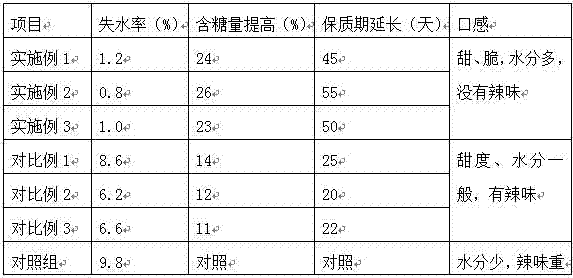Storage and preservation method for radish
A technology for storage and preservation of radishes, which is applied in the fields of fruit and vegetable preservation, fruit/vegetable preservation through freezing/refrigeration, and food preservation. Sweet and crunchy flavor, the effect of reducing the spicy taste
- Summary
- Abstract
- Description
- Claims
- Application Information
AI Technical Summary
Problems solved by technology
Method used
Image
Examples
Embodiment 1
[0016] A method for storing fresh-keeping of radish includes the following steps:
[0017] (1) The radishes are irrigated with large water 3 days before harvest, and harvested at 8-10 in the morning. The radishes are sorted and screened to remove the radishes with pests, diseases and skin damage, and the qualified radishes are rinsed with clean water ,Pre-cooling at 0℃ for 12 hours, after pre-cooling, apply a layer of edible preservative on the epidermis of radish, which is made of the following ingredients according to mass percentage: sodium alginate accounts for 0.1%, chitosan accounts for 0.3 %, sodium carboxymethyl cellulose accounts for 0.5%, citric acid accounts for 1.3%, starch accounts for 1.5%, vegetable oil accounts for 2.5%, soybean protein accounts for 3.5%, and the rest is water;
[0018] (2) After drying the radish coated with anti-staling agent on the surface, burying it in the sand mixed with anti-insect and anti-bacterial agent. The ratio of the sand to soil is sa...
Embodiment 2
[0024] A method for storing fresh-keeping of radish includes the following steps:
[0025] (1) The radishes shall be irrigated with large water 4 days before harvest. The radishes shall be harvested at 9 o'clock in the morning. The radishes will be classified and screened to remove the radishes with pests, diseases and skin damage, and the qualified radishes shall be rinsed with clean water and placed Pre-cooling at 2°C for 15 hours. After pre-cooling, apply a layer of edible antistaling agent on the epidermis of radish. The antistaling agent is made of the following ingredients according to mass percentage: sodium alginate accounts for 0.2%, chitosan accounts for 0.4%, Sodium carboxymethyl cellulose accounts for 0.6%, citric acid accounts for 1.4%, starch accounts for 2.0%, vegetable oil accounts for 2.7%, soy protein accounts for 4.0%, and the rest is water;
[0026] (2) Dry the radish coated with antiseptic on the surface antiseptic, and then bury it in sand mixed with anti-inse...
Embodiment 3
[0032] A method for storing fresh-keeping of radish includes the following steps:
[0033] (1) The radishes shall be irrigated with large water 5 days before harvest, and harvested at 10 am. The radishes are classified and screened to remove the radishes with pests, diseases and skin damage, and the qualified radishes are rinsed with clean water and placed Pre-cool at 5°C for 18 hours. After pre-cooling, apply a layer of edible antistaling agent on the epidermis of radish. The antistaling agent is made of the following ingredients according to mass percentage: sodium alginate accounts for 0.3%, chitosan accounts for 0.5%, Sodium carboxymethyl cellulose accounts for 0.7%, citric acid accounts for 1.5%, starch accounts for 2.5%, vegetable oil accounts for 3.0%, soy protein accounts for 4.5%, and the rest is water;
[0034] (2) After drying the surface preservative of the radish coated with antistaling agent, bury it in the sand mixed with the anti-insect antibacterial agent. The rati...
PUM
 Login to View More
Login to View More Abstract
Description
Claims
Application Information
 Login to View More
Login to View More - Generate Ideas
- Intellectual Property
- Life Sciences
- Materials
- Tech Scout
- Unparalleled Data Quality
- Higher Quality Content
- 60% Fewer Hallucinations
Browse by: Latest US Patents, China's latest patents, Technical Efficacy Thesaurus, Application Domain, Technology Topic, Popular Technical Reports.
© 2025 PatSnap. All rights reserved.Legal|Privacy policy|Modern Slavery Act Transparency Statement|Sitemap|About US| Contact US: help@patsnap.com

